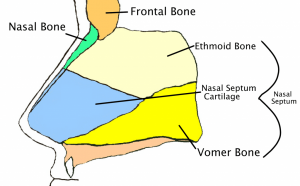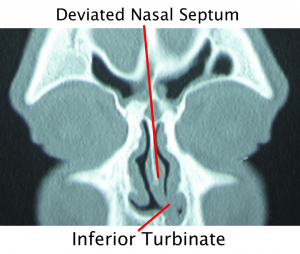Your path to breathing better begins here: Solve your deviated septum issue
If you live in the Upper East Side and are experiencing persistent difficulty breathing through your nose, it may indicate the presence of a deviated septum, a condition where the nasal passages are shifted or misaligned. This can lead to ongoing breathing challenges, sinus problems, and reduced overall comfort. Dr. Mourad is a specialist in diagnosing nasal conditions and provides expert treatment for deviated septum issues. Through precise and carefully planned septoplasty, patients in the Upper East Side can achieve improved airflow, enhanced comfort, and better overall nasal function.
Relieve your breathing problems with septoplasty in the Upper East Side – Meet with Dr. Mourad
Septoplasty Procedure to Improve the Nasal Passages
Septoplasty is a specialized surgical procedure aimed at correcting problems caused by a deviated septum, with the main objective of improving airflow and overall breathing efficiency through the nasal passages. The surgery is typically performed on an outpatient basis and involves the careful reshaping, repositioning, or removal of cartilage and bone within the nose to restore proper alignment. By correcting these structural irregularities, septoplasty not only enhances the functional capacity of the nasal passages but also helps alleviate symptoms such as difficulty breathing, chronic nasal congestion, and other related discomforts, providing patients with lasting relief and improved nasal performance.

How Can Dr. Mourad Improve my Quality of Life with Deviated Septum Surgery?
Many of our Upper East Side patients come to us after having tried a variety of conventional treatments, including nasal steroid sprays, oral decongestants, and antihistamines, yet they continue to experience difficulty breathing and persistent nasal discomfort. At our practice, we dedicate the time necessary to carefully review all available treatment options with each patient, ensuring that you are fully informed and confident in the care plan recommended for your specific needs. Our team also takes responsibility for verifying your insurance benefits and guiding you through any required processes, making the overall experience as smooth as possible. Dr. Mourad, recognized as a leading specialist in all forms of nasal surgery, is always available to discuss your individual concerns and provide care of the highest quality.
Do I Need a Septoplasty?
The necessity of septoplasty depends largely on whether a deviated septum is present and whether it is causing significant health issues or symptoms that interfere with everyday activities. Common concerns that may indicate the need for this procedure include difficulty breathing through the nasal passages, repeated sinus infections, frequent nosebleeds, snoring that disrupts sleep, and sleep apnea.
Many patients first attempt to manage these symptoms using non-surgical measures, such as prescription or over-the-counter nasal sprays, in order to relieve congestion and improve airflow. However, when these approaches are insufficient or when nasal symptoms are persistent and severe, septoplasty becomes the recommended course of action. For individuals experiencing these challenges, arranging a consultation at our NYC clinic ensures a comprehensive evaluation by a skilled facial plastic and reconstructive surgeon who can determine the best treatment plan.

Common Symptoms of a Deviated Nasal Septum
Recognizing the presence of a deviated septum usually starts with noticing ongoing symptoms such as chronic nasal obstruction, consistent pressure or discomfort in the facial region, and recurrent sinus infections. When these symptoms begin to interfere noticeably with normal breathing or impact daily life, surgical intervention in the form of septoplasty may be advised. This procedure carefully adjusts and realigns the cartilage and bones within the nasal passages, helping to restore proper airflow and alleviate the discomfort caused by the structural deviation.
- Sleep Apnea and Other Sleeping Problems: Misalignment of the nasal septum can disrupt airflow during sleep, which may play a role in obstructive sleep apnea. This can result in restless sleep, frequent nighttime awakenings, and fatigue throughout the day. Septoplasty may be recommended to realign the septum, improve nasal airflow, and help patients achieve a more restful and uninterrupted sleep, reducing the risks associated with compromised breathing during the night.
- Chronic Nose Congestion or Nasal Obstruction: Persistent nasal obstruction, often linked to a deviated septum, can make it difficult to breathe comfortably through the nose. Surgical correction can restore proper nasal passage alignment, relieve ongoing congestion, and significantly improve the patient’s ability to breathe naturally and comfortably.
- Chronic Sinusitis and Sinus Infections: A septum that is out of alignment can block sinus drainage pathways, leading to recurrent infections. Surgical realignment addresses these structural issues, enhancing airflow and promoting proper sinus ventilation, which helps reduce both the frequency and severity of sinus infections.
- Nasal Discharge (Runny Nose): Deviations in the septum can lead to irritation of the nasal mucosa, causing excessive mucus production or a constantly runny nose. Surgical correction can restore normal nasal function, reduce unwanted discharge, and improve overall respiratory comfort.
- Nasal Polyps: Nasal polyps, which are soft, benign growths, may develop alongside a deviated septum and obstruct airflow. These growths can impair the sense of smell and make nasal infections more likely. Surgical treatment may be advised to remove polyps and restore proper nasal passage function.
- Symptoms Similar to Allergies: Symptoms such as sneezing, nasal congestion, and watery discharge that resemble allergic reactions can sometimes be caused by structural issues within the nose rather than true allergens. Proper evaluation by a specialist is crucial to determine the cause, and surgical intervention may be necessary to correct structural abnormalities and achieve effective long-term relief.
Why Choose Mourad NYC for Septoplasty Surgery in the Upper East Side?
Choosing Mourad NYC for septoplasty surgery ensures that you are working with surgeons who possess extensive expertise in the intricate structures of the nose and advanced surgical techniques. This Upper East Side-based practice is dedicated to providing highly personalized care that addresses both the functional and cosmetic aspects of nasal health. Whether your goal is to relieve nasal obstruction, correct a deviated septum, or combine your procedure with aesthetic improvements such as rhinoplasty, Mourad NYC employs cutting-edge technology and a comprehensive, patient-focused approach. By placing your care in the hands of Dr. Mourad, you benefit from the skills of a facial plastic surgeon committed to achieving optimal results and a smooth, comfortable recovery. Septoplasty in the Upper East Side can significantly enhance your breathing, overall health, and quality of life.
Learn More About Deviated Septum Surgery at Mourad NYC
What is a Deviated Septum?
A deviated septum occurs when the cartilage and bone forming the nasal septum, which serves as the partition between the nostrils within the nasal cavity, become misaligned or displaced from their normal anatomical position. This condition can result from physical trauma, such as a direct injury to the nose, or from congenital factors that affect development before birth. Individuals with a deviated septum may experience persistent nasal congestion, difficulty breathing through one or both nostrils, and in some cases, the development of nasal polyps. Surgical interventions, including septoplasty or combined procedures such as rhinoplasty, are commonly performed to correct these structural irregularities, restore proper airflow, and improve overall nasal function.
Does Health Insurance Pay For This Type Of Nasal Surgery?
Most health insurance plans in the United States generally provide coverage for functional nasal surgeries, which are procedures intended to improve the functional performance of the nose rather than purely cosmetic outcomes. At our New York City office, we take the time to thoroughly review each patient’s insurance benefits and clearly explain any potential financial responsibility that may arise should septum surgery be necessary.
Our team prioritizes transparency and works to prevent any unexpected expenses, keeping patients fully informed about co-pays, deductibles, and coinsurance amounts so they can plan appropriately. While functional procedures are typically covered, it is important to understand that elective or cosmetic surgeries, including aesthetic rhinoplasty, blepharoplasty, and similar procedures, are not included in standard insurance plans and require separate financial arrangements.
What is the Cost of a Septoplasty Surgery in NYC?
The typical price range for facial plastic surgery aimed at correcting a deviated septum in New York City generally falls between approximately $4,000 and $10,000. It is important to understand that this estimate is only a general guideline, and the actual cost for any individual patient may differ depending on a variety of factors, including the complexity of the procedure, the specific techniques employed, and individual anatomical considerations.
When determining the total expenses associated with septoplasty in NYC, several important components should be considered. These include the surgeon’s professional fees, charges for anesthesia, the costs of the operating room and facility, as well as post-operative care and follow-up visits. To obtain a precise and personalized cost estimate, it is highly recommended to schedule a consultation with a qualified facial plastic surgeon who can evaluate your unique nasal structure, discuss any additional procedures that may be necessary, and provide a detailed breakdown of all anticipated fees.
What is the recovery time following septoplasty?
Recovery following a septoplasty procedure can vary depending on each patient’s individual healing process. Generally, most people can expect to return to non-strenuous daily activities or their usual work routine within approximately one week after surgery. Complete healing, including the full resolution of internal nasal swelling and restoration of normal nasal function, may take anywhere from three to six months. During the initial recovery period, it is particularly important to avoid physically demanding activities, refrain from forcefully blowing the nose, and remain cautious to prevent any trauma or impact to the nasal area.
Are There Other Conditions That Can Block Your Nasal Airway?
In addition to a deviated septum, several other conditions can contribute to nasal obstruction and interfere with proper airflow. These include enlarged turbinates, nasal polyps, and chronic sinus infections. Evaluating these factors and carefully weighing the potential benefits and risks of surgical interventions, such as septoplasty, is essential for achieving optimal nasal function and long-term comfort.
What are potential risks of deviated septum surgery?
Like any surgical procedure, septoplasty carries certain potential risks and complications that patients should be fully aware of before proceeding. Understanding these possibilities allows individuals to make informed decisions about their care, anticipate the recovery process, and take appropriate measures to promote healing while minimizing complications.
Nose Infection
Infections can develop within the nasal cavity or at the site of surgery, representing a possible complication following septoplasty or other nasal procedures. Adhering closely to all post-operative care instructions, including taking any prescribed antibiotics as directed, is essential for reducing the risk of infection and promoting proper healing throughout the recovery process.
Septal Perforation
A septal perforation, which occurs when a hole forms in the cartilage of the nasal septum, is a rare but serious complication. This condition can affect normal airflow and nasal function, and in some cases, may necessitate additional medical or surgical interventions to correct the problem and restore proper nasal anatomy.
Prolonged or Intense Pain
While some degree of pain is expected after surgery, there is a possibility that discomfort could persist for a longer period or become more severe. Such situations may arise if complications occur, including the formation of a hematoma or issues related to the healing of nasal tissues.
Facial Pain
Changes to the nasal bones or cartilage during surgery can sometimes result in facial discomfort. It is important to discuss the potential for facial pain during pre-surgery consultations to set realistic expectations and ensure that patients are prepared for the recovery experience.
Persistent Nasal Congestion
Although mild congestion is typical during the initial recovery phase, prolonged or severe nasal blockage may indicate a complication in the healing process or alterations to normal nasal airflow. Monitoring these symptoms closely is recommended to address any issues promptly.
Nasal Packing Complications
Nasal packing may be used to control post-operative bleeding, but it can cause discomfort and, if not carefully managed, may lead to additional complications. Proper removal and monitoring are essential to avoid further problems during the healing process.
Alterations to Nasal Structure
Surgical procedures can result in changes to the shape and structure of the nose, including modifications to cartilage and bone. Patients should discuss their desired outcomes in detail with their surgeon beforehand to prevent unexpected or undesired results and to ensure satisfaction with the final appearance.

